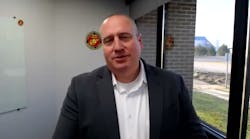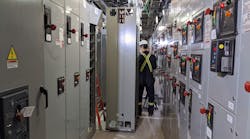Smoke was all Patrick Adams could see when he stepped onto the platform — smoke and people stumbling and coughing as they searched the underground rail station for exits. As Adams would later tell investigators for the National Transportation and Safety Board (NTSB), the scene was nothing short of “chaotic.”
Adams is a rail supervisor for the Washington Metropolitan Area Transit Authority (WMATA). At 3:10 p.m. on Jan. 12, 2015, he was dispatched to the Washington Metro rapid transit system’s L’Enfant Plaza station after hearing reports of smoke in the tunnel. Within minutes of his arrival, smoke was so thick in the massive two-story station that Adams and first responders on the scene from Metro Police and D.C. Fire could barely see each other. But they had to evacuate, and their highest priority was getting everyone out of the two trains stopped in the tunnel just beyond the platform. Riders were so desperate to get out of the smoke-filled cars that they disembarked on the tracks and climbed up to safety. By the time the chaos subsided that afternoon, 86 passengers had been taken to area hospitals. Two were in critical condition; one was dead.
It was clear almost from the start where the smoke had originated: Nearly 16 feet of power cables feeding the train’s third rail had burned up. The affected portions of the cables were consumed in the fire. But what little evidence remained was illuminating. Investigators found copper splatter on the wall near where a cable connection would have been, and the connector and boot that should have been there were gone. The ends of the cables, according to a preliminary NTSB report, “had a melted and beaded appearance consistent with conductors that had gone through electrical arcing.” And on the cables that remained, the insulating sheathing “had been burned back and thermally damaged. This damage to the insulation varied in the degree of how far back it extended from the exposed conductor.”
So having determined that an arc fault had ignited the fire that produced the smoke, it was up to the NTSB to figure out what had caused the fault — and how it could have been prevented.
Everything old is new again
The first Washington Metro trains began running in March 1976. Although the technology that supports rail transit systems has changed significantly over the last four decades — fiber-optic communications, SCADA points that provide data on everything from train doors to alarms, and signaling systems that supply arrival times to reader boards on the platform — the technology that powers it hasn’t. “You’re feeding 600VDC into the third rail, and the shoe that rides on top of the rail picks up the current and brings it into the train,” says Gus Ubaldi, a forensic engineer with expertise in railroad design. “This technology has been around for more than 100 years.”
Those non-power-related changes have kept contractors like Aldridge Electric busy. In 2013, the Chicago-based firm removed, rehabilitated, and installed more than 145 miles of signal and communications cable on the Chicago Transit Authority’s Dan Ryan Red Line. Sure, the contractor replaced third rail traction cable as well, but it’s those secondary systems that transit agencies are most interested in now. That’s because they not only increase safety, but they also keep the trains running on time.
The fact that power supply systems haven’t evolved substantially since the inception of electrified transit creates a paradox: In the absence of technological advances that would necessitate swapping out of older infrastructure, power cables can remain in use for decades. In some cases, that’s not an issue. When Aldridge did its work on the CTA’s Red Line, much of the existing cabling it pulled out — which had been in use since the 1990s — still looked brand new. In other cases, like in the tunnels of WMATA’s underground rail system, cabling can wear out in a matter of months.
On June 23 and 24, 2015, WMATA officials answered questions at an NTSB investigative hearing meant to get to the root cause of the fatal smoke incident that occurred six months earlier. And, over the course of nearly 16 hours of testimony, they revealed that the harsh environment in the tunnels has made cable maintenance a challenge. In particular, water intrusion is an ongoing problem. “We are constantly chasing water leaks,” Clay Bunting, director of capital projects, told investigators. Bunting went on to explain that there are approximately 3,000 to 5,000 leaks in the system at any given time.
In order to track and identify cable degradation, WMATA established a crew dedicated to an “intense, full-time” Meggering program in the 1990s, according to Paul Miller, assistant director of the track access and support services group. “In other words, you’re looking for a possible path between the conductor, which is energized or could be energized at a later date, to a known ground source or a negative reference,” Miller testified. “And the results of that Meggering program told us very clearly where we had to take immediate action to start our cable replacement program.”
WMATA has scaled back the Meggering program in recent years and now only deploys it on an as-needed basis. That’s due in part to the fact that the agency monitors third-rail cable integrity quarterly using a thermal imaging camera affixed to a train. And, as Miller pointed out, the camera doesn’t identify cable degradation, but it does show anomalies. “If all the connections are cool, you’re going to see an ambient air temperature of probably whatever is in the tunnel,” Miller explained. On occasion, though, the camera will reveal a connection with an elevated temperature. “What that tells us is that there’s something that needs to be investigated with that cable. It could be anything from a little bit of water on the cable [to] a loose connection.”
Not all of the cabling in WMATA’s system is subjected to the elements. In fact, some of it is still original and, according to Miller’s testimony, tests/looks as if it’s in pristine condition. However, the agency replaces 80,000 feet of cable per year — some of it after just 16 months of use. As of June 2015, it had swapped out 70% to 80% of the track feeder cables on the main line, including those near L’Enfant Plaza. So if the cables themselves weren’t at fault for the smoke incident, what was?
An accident waiting to happen
Where there’s smoke, there’s fire. And a fire needs not only an ignition source, but also fuel. “By design, most cable insulation materials aren’t good fuel,” says Daryl Ebersole, a forensic engineer with Robson Forensic. But transit tunnels produce no shortage of fuel. Brake dust, rust particles, rail and wheel wear debris — all of it can accumulate on cables and connectors. “And if there aren’t any practices to keep that clean, of course you start to get arc tracking across debris. And depending on where joints are, where uninsulated materials are, where cracks in the insulation are, you can get ignition — and then, of course, charring and then smoke.”
There was little question that the tunnels in D.C. were thick with debris. WMATA’s Clay Bunting reported in the June 23 hearing that the agency had cleaned 30,000 insulators in the previous five years and replaced 40,000 more over that same period. It did not, however, have a program in place for cleaning the third rail cables. The agency focused instead “on the insulators between the track bed and the bottom of the third rail,” Bunting explained.
Washington Metro experienced hundreds of smoke and fire events between 2011 and 2014. In fact, after a 30% drop in 2013, the number of fires in the tunnels jumped to 69 in 2014. Not only that, WMATA’s Bunting and Miller testified that the system had as many as 200 smoke events in just the first six months of 2015. Four of them, including the incident at L’Enfant Plaza, began as a result of arcing.
It was the second event, which took place less than one month later and resulted in no injuries or fatalities, that ultimately helped the NTSB untangle what had happened in January. According to an NTSB report released on June 8, “arc tracking occurred between a terminal lug inside a cable connector assembly and extended along the surface of a section of the pigtail cable leading to the third rail.” WMATA design specs stipulate that power cable connector covers be installed with sealing sleeves; and as long as they are, those connectors will be watertight. And yet the connectors involved in the second arcing event were installed without sealing sleeves. Not only that, when investigators checked other cable connectors in the system that had not been involved in arcing events, they found the same thing. In many cases, heat-shrink tubing or electrical tape had been used instead of sealing sleeves.
Compounding the problem at L’Enfant Plaza were the water leaks that WMATA officials admitted to having to constantly fight. Where the affected cables had lain, investigators found standing water. Water flowed freely where arcing damage was found on the tunnel wall. And the tunnel wall itself — much of it metal — was rusty and corroded.
Ironically, despite having so many processes in place to ensure the safety of the system — Meggering, thermal imaging, routine cable replacement, insulator cleaning — WMATA did not have a program for ensuring that cable connectors were installed to the system’s engineering design specifications. As the NTSB’s investigation progressed, several inadequate connector assemblies were found in the tunnels under Washington, D.C., many of which were missing sealing sleeves and used a variety of terminal lugs.
Perhaps most damning, though, was the fact that the repairs made to the power cables outside L’Enfant Plaza were made without the appropriate sealing sleeves. As of October 2015, the NTSB’s investigation was ongoing, and the bureau had yet to issue a final ruling. (NTSB representatives declined to comment for this story.) But the reams of pages of reports it had released over the prior 10 months laid out a compelling case for what had happened: Poor installation methods had left power cable connectors susceptible to the corrosive environment that naturally exists in train tunnels. Furthermore, a seemingly unstoppable deluge of water into those tunnels took its toll on those connectors, until they shorted out and started a fire.
Given that combination of elements, the question isn’t how the incident that hospitalized so many and killed one happened in the first place. It’s why didn’t it happen sooner?
Plan for failure
As Gus Ubaldi, the forensic engineer points out, commuter trains make thousands of runs every day without a single rider suffering an injury or dying. So he scoffs at the notion that the country’s transportation infrastructure is falling apart. “The infrastructure has to be maintained,” he says. “But I don’t see it as something that people should be frightened about.”
In fact, were in not for an unfortunate confluence of other conditions — the trains were taken offline, exhaust fans sucked air into the tunnel instead of blowing the smoke out — the incident at L’Enfant Plaza might have been a mild inconvenience rather than a fatality accident.
But according to Ubaldi and Daryl Ebersole, it underscores the importance of a regular maintenance program. Constant monitoring; replacing old, degrading cables; and instituting programs to keep debris and other contaminants out of the system — each can be the difference between life and death in the public transit systems that so many rely on every day to get to and from work.
But what if one of those options isn’t available? “Of course, one way to keep things in good condition would be to periodically change the cables,” Ebersole says. “But in most systems, that doesn’t happen.” Or, as Ubaldi points out, sometimes it can’t. “Remember, the cables that come up out of the ground go back a couple hundred feet to a substation. So in order to replace the portion sticking up out of the ground, you have to somehow make the connection back under ground,” he says. “So do you dig it up and make a connection there? Well, then water could get in there.”
In that case, the answer to preventing these accidents is simple: Keep it clean.
Halverson is a contributing writer based in Seattle. He can be reached at [email protected].




